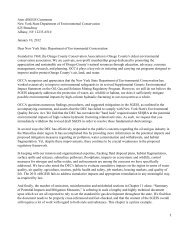Oil and Gas at Your Door? (2005 Edition) - Earthworks
Oil and Gas at Your Door? (2005 Edition) - Earthworks
Oil and Gas at Your Door? (2005 Edition) - Earthworks
Create successful ePaper yourself
Turn your PDF publications into a flip-book with our unique Google optimized e-Paper software.
IMPACTS ASSOCIATED WITH OIL AND GAS<br />
st<strong>and</strong>ards for oil <strong>and</strong> grease content, <strong>and</strong> pass a toxicity test prior to discharge. There are some<br />
neg<strong>at</strong>ive effects associ<strong>at</strong>ed with this practice:<br />
• Often, enormous quantities of CBM produced w<strong>at</strong>er are discharged all year long, which<br />
alters the seasonal n<strong>at</strong>ure <strong>and</strong> timing of n<strong>at</strong>ural flows. If such practices are allowed to continue,<br />
the w<strong>at</strong>er volume of some rivers may be doubled, <strong>and</strong> streamside trees <strong>and</strong> plants<br />
th<strong>at</strong> have adapted to the previous w<strong>at</strong>er conditions may not be able to survive. 309<br />
• Dumping large volumes of produced w<strong>at</strong>er into streams can wash away stored nutrients,<br />
<strong>and</strong> without these food sources, aqu<strong>at</strong>ic organisms may not be able to survive.<br />
• In Wyoming <strong>and</strong> Montana, it is common practice to dump produced w<strong>at</strong>er from CBM oper<strong>at</strong>ions<br />
into streams. Often, however, discharges are permitted into streams <strong>and</strong> rivers without<br />
proper testing. 310 This poses a danger to aqu<strong>at</strong>ic life <strong>and</strong> l<strong>and</strong>owners living downstream<br />
who use the w<strong>at</strong>er for irrig<strong>at</strong>ion, since the produced w<strong>at</strong>er may contain high concentr<strong>at</strong>ions<br />
of salts <strong>and</strong> dissolved solids.<br />
Surface Discharge: Discharges of produced w<strong>at</strong>er on l<strong>and</strong> may flood the property of l<strong>and</strong>owners,<br />
which can lead to erosion <strong>and</strong> damage to soils <strong>and</strong> plants. 311 The effects of the surface disposal<br />
of produced w<strong>at</strong>ers can also include swamping; silt<strong>at</strong>ion of streams, lakes, <strong>and</strong> reservoirs;<br />
<strong>and</strong> contamin<strong>at</strong>ion of soil, ground w<strong>at</strong>er <strong>and</strong> surface w<strong>at</strong>er by salts, hydrocarbons, metals,<br />
<strong>and</strong> radioactive m<strong>at</strong>erials. 312<br />
The discharge of produced w<strong>at</strong>er inappropri<strong>at</strong>ely onto soil can result in salinity levels too high<br />
to sustain plant growth. In some areas, however, produced w<strong>at</strong>er may contain low enough levels<br />
of salt th<strong>at</strong> it may be used for beneficial use for irrig<strong>at</strong>ion or livestock w<strong>at</strong>ering.<br />
Occasionally, produced w<strong>at</strong>er is spread on roads as a dust suppressant. Roadspreading is<br />
declining as a disposal option, however, <strong>and</strong> in 1995 it accounted for less than 1 % of produced<br />
w<strong>at</strong>er disposal. 313<br />
NATURALLY OCCURRING RADIOACTIVE MATERIALS (NORM)<br />
N<strong>at</strong>urally occurring radioactive m<strong>at</strong>erials may be present in oilfield solid or liquid wastes. As<br />
well, radioactivity may be found on oil or gas industry equipment. 314<br />
Depending on the geology, subsurface form<strong>at</strong>ions may contain radioactive m<strong>at</strong>erials such as uranium<br />
<strong>and</strong> thorium <strong>and</strong> their daughter products, radium 226 <strong>and</strong> radium 228. Radionuclides are<br />
leached into groundw<strong>at</strong>er or surface w<strong>at</strong>er when the w<strong>at</strong>er comes in contact with uranium- <strong>and</strong> thorium-bearing<br />
geologic layers. NORM can be brought to the surface in produced w<strong>at</strong>er from these form<strong>at</strong>ions.<br />
In addition, radon gas, a radium daughter, may be found in produced n<strong>at</strong>ural gas. 315<br />
The primary carrier of the NORM is the produced w<strong>at</strong>er from the reservoir. When the produced<br />
w<strong>at</strong>er is brought to the surface, the changes in temper<strong>at</strong>ure, pressure <strong>and</strong> salinity cause a scale<br />
to form. 318 For example, radium 226 <strong>and</strong> 228 found in produced w<strong>at</strong>ers may become concentr<strong>at</strong>ed<br />
by <strong>at</strong>taching to barium sulf<strong>at</strong>e scale in well tubulars <strong>and</strong> surface equipment. Elev<strong>at</strong>ed<br />
concentr<strong>at</strong>ions of radium 226 <strong>and</strong> 228 may also occur in sludge th<strong>at</strong> accumul<strong>at</strong>es in oilfield<br />
pits <strong>and</strong> tanks. 319 Often, high concentr<strong>at</strong>ions of oil-<strong>and</strong>-gas-rel<strong>at</strong>ed NORM are associ<strong>at</strong>ed with<br />
separ<strong>at</strong>or tanks, w<strong>at</strong>er storage tanks, <strong>and</strong> w<strong>at</strong>er lines where brine scale <strong>and</strong> tank sludge accumul<strong>at</strong>e.<br />
320 Consequently, workers employed in the area of cutting <strong>and</strong> reaming oilfield pipe,<br />
removing solids from tanks <strong>and</strong> pits, <strong>and</strong> refurbishing gas processing equipment may be<br />
exposed to radioactive m<strong>at</strong>erials th<strong>at</strong> could pose health risks. 321 The main health risks for<br />
humans are direct gamma radi<strong>at</strong>ion from NORM-bearing soils <strong>and</strong> equipment, bre<strong>at</strong>hing of<br />
NORM-bearing dust, or bre<strong>at</strong>hing indoor radon in structures built on NORM-affected soils. 322<br />
The U.S. EPA estim<strong>at</strong>es<br />
th<strong>at</strong> 30 % of producing<br />
oilfields in the United<br />
St<strong>at</strong>es have enough<br />
NORM to warrant health<br />
<strong>and</strong> environmental concerns.<br />
316 One industry<br />
estim<strong>at</strong>e suggests th<strong>at</strong> if<br />
strict regul<strong>at</strong>ory requirements<br />
for assessment<br />
<strong>and</strong> cleanup of NORM<br />
were put in place in the<br />
United St<strong>at</strong>es, 20 % of oil<br />
production <strong>and</strong> 8 % of<br />
gas production would<br />
become uneconomic. 317<br />
I-61




